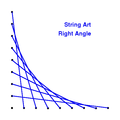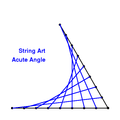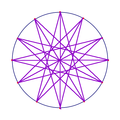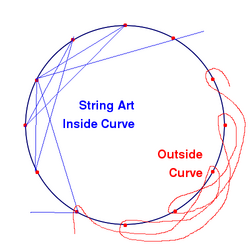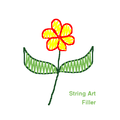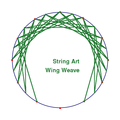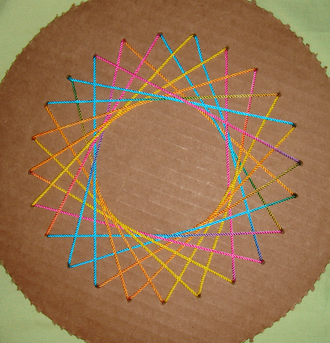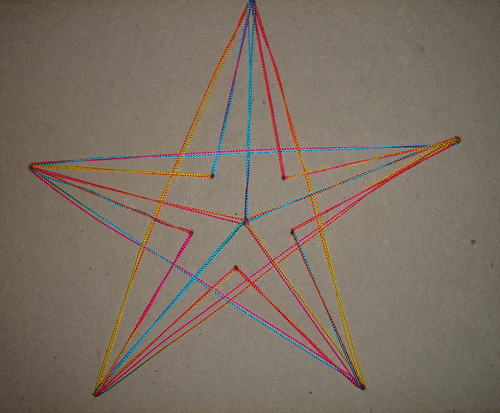Difference between revisions of "AY Honors/String Art/Answer Key"
From Pathfinder Wiki
< AY Honors | String ArtAY Honors/String Art/Answer Key
m (formatting) |
|||
| (8 intermediate revisions by the same user not shown) | |||
| Line 25: | Line 25: | ||
===a. Filled circle=== | ===a. Filled circle=== | ||
: In a 'Filled circle', the string would cross the center point of the circle. There would be no empty space in the center area of the circle. | : In a 'Filled circle', the string would cross the center point of the circle. There would be no empty space in the center area of the circle. | ||
| + | <gallery> | ||
| + | Image:StringArt-FilledCircle.png|Filled Circle | ||
| + | </gallery> | ||
===b. Hollowed circle=== | ===b. Hollowed circle=== | ||
: In a 'Hollowed circle', the string would not go pass the center point of the circle. There would be no string in the center area of the circle. | : In a 'Hollowed circle', the string would not go pass the center point of the circle. There would be no string in the center area of the circle. | ||
| − | + | <gallery> | |
| + | Image:StringArt-HollowCircle.png|Hollow Circle | ||
| + | Image:StringArt-HollowCircle2.png|Hollow Circle | ||
| + | </gallery> | ||
===c. Star=== | ===c. Star=== | ||
| + | : The hollow and filled circles are also of a star design. | ||
| + | <gallery> | ||
| + | Image:StringArt-HollowCircle.png|Star design with hollow circle | ||
| + | Image:StringArt-FilledCircle.png|Star design with filled circle | ||
| + | </gallery> | ||
===d. Edging=== | ===d. Edging=== | ||
| + | [[Image:StringArt-InsideOutside.png|thumb|200px|Curve from within, Curve from without]] | ||
| + | : Edging basically ''edges'' or outlines the design. | ||
===e. Curve from within === | ===e. Curve from within === | ||
| + | : When you ''curve from within'' the string covers some part of the inside curve. | ||
===f. Curve from without === | ===f. Curve from without === | ||
| + | : The ''Curve from within'' and ''Curve from without'' are two different types of ''edging''. In the example here, we are using a circle. Edging basically ''edges'' the design. When you ''curve from within'' the string covers some part of the inside curve. When you ''curve from without'' the string does not cross the space on the inside of the curve. | ||
| + | |||
| + | <br> | ||
| + | |||
===g. Filler=== | ===g. Filler=== | ||
| + | <gallery> | ||
| + | Image:StringArt-Filler.png|Filler, the zig-zag parts in the leaves | ||
| + | </gallery> | ||
===h. Wing weave === | ===h. Wing weave === | ||
| + | <gallery> | ||
| + | Image:StringArt-WingWeave.png|Wing Weave, using existing circle template | ||
| + | </gallery> | ||
==5. Complete one original string art hanging on wood for display.== | ==5. Complete one original string art hanging on wood for display.== | ||
| + | : This is your part. Enjoy! | ||
| + | {|border=0 | ||
| + | |- | ||
| + | |[[Image:StringArt-Project1.png|left|thumb|300px]] | ||
| + | |[[Image:StringArt-Project2.png|right|thumb|380px]] | ||
| + | |} | ||
| + | {{clear}} | ||
| + | |||
==References== | ==References== | ||
| − | [[Category:Adventist Youth Honors Answer Book|{{SUBPAGENAME}}]] | + | [[Category:Adventist Youth Honors Answer Book/Completed Honors|{{SUBPAGENAME}}]] |
* http://www.b4scouts.com/Library/String_Art_NZ.pdf | * http://www.b4scouts.com/Library/String_Art_NZ.pdf | ||
Revision as of 02:27, 9 October 2008
1. Describe the following: string craft, symmography, geometric stitchery.
- String Craft
- String Craft is making something (craft or art) out of string.
- Symmography
- Symmography is creating 3D designs with string without knotting or knitting.
- Geometric Stitchery
- Geometric Stitchery is like Symmography but instead of using nails to hold the string on the surface of the media you use a needle or precut holes to go through the media and come out to a new point in the media. Much like sewing on a patch.
2. Draw and stitch on cardboard in equally spaced points:
3. Name three ways to prepare wood for string art.
Paint, Stain, or Lacquer (clear):
- Paint
- Paint covers the wood and gives you a smooth surface with the color(s) of your choice.
- Stain
- Stain changes the color of the wood while still showing the nature and texture of the wood. Stained wood can be lacquered or varnished to make it glossy.
- Lacquer
- Lacquer (clear) protects the wood without changing its color. It leaves a glossy finish.
4. Use stringing methods on wood to do four of the following:
a. Filled circle
- In a 'Filled circle', the string would cross the center point of the circle. There would be no empty space in the center area of the circle.
b. Hollowed circle
- In a 'Hollowed circle', the string would not go pass the center point of the circle. There would be no string in the center area of the circle.
c. Star
- The hollow and filled circles are also of a star design.
d. Edging
- Edging basically edges or outlines the design.
e. Curve from within
- When you curve from within the string covers some part of the inside curve.
f. Curve from without
- The Curve from within and Curve from without are two different types of edging. In the example here, we are using a circle. Edging basically edges the design. When you curve from within the string covers some part of the inside curve. When you curve from without the string does not cross the space on the inside of the curve.
g. Filler
h. Wing weave
5. Complete one original string art hanging on wood for display.
- This is your part. Enjoy!
